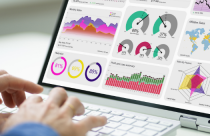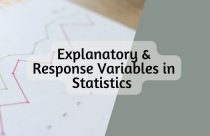Chartjunk: How to Avoid Confusing Elements in Your Figures

Chartjunk, coined by Edward Tufte in his book entitled The Visual Display of Quantitative Information, refers to decorations in a graphic that have no purpose. In many cases, researchers add these (e.g., different patterns in a histogram) to try to make the graphic look more “technical”; however, these usually add nothing to the message that the image is trying to convey.
As a researcher, your figures support your data. In scientific disciplines, whether your reader is a visual learner or can comprehend information without a visual, a graphic is always helpful.
Avoid the Junk!
It would be easy for you to fall into the trap of adding chartjunk to embellish your figures. At times this might be necessary, but chartjunk sometimes gets in the way of the message that you’re trying to convey.
Regardless of how many squiggly lines and colorful inserts you provide in your figure, your data might not add more value to the reader. Also, if the figure becomes too cluttered, it can be distracting. Subsequently, the reader might lose interest in your message.
That said, there are pros and cons to this assessment.
Pro-Embellishment
Bateman et al. presented embellished and plain figures to participants of a study and measured their reactions. They assessed interpretations of the data and whether the participants remembered the presentations.
The researchers presented only a few points:
- Participants could equally describe both types of figures.
- Participants could remember the embellished charts better than the plain charts.
- Participants preferred the embellished to the plain graphics.
Does this mean that chartjunk is a good thing?
Anti-Embellishment
Stephen Few of the Perceptual Edge’s Visual Business Intelligence Newsletter, disagrees. Few points out that it’s part of our nature to recall something that makes an impression on us. If an embellishment makes an impression, we remember it. What the study did not reveal was that after three weeks, the ability to recall both types of figures was the same.
We tend to remember clever and entertaining images, such as those used in the study. But simply recalling the visual doesn’t mean that the viewer has remembered the data. Even though the participants enjoyed the embellished graphics better than the plain ones, the comparison was limited by the few examples provided to the study group.
How Do You Decide?
As a researcher, you must decide what is important and how to ensure that your audience understands the results of your work. Part of the goals of scientific research is to inform the public. How you present this information might be just as important as the information itself.
There are many types of graphics that you can use to present your data, such as linear plots, bar graphs, and pie charts. There are also some basic rules to creating these images that you should follow. These will help to ensure that you present the information in the simplest format and without chartjunk.
Rules for Creating Figures
In a 2014 article in PLOS Computational Biology, the authors presented 10 rules for creating figures that avoid chartjunk as follows.
- Know your audience: Keep your audience in mind when you create your images. Your audience at a symposium is different from that reading your article in a scientific journal.
- Know your figure’s message: Identify what you’re trying to convey. Your figure should help, not hinder, comprehension of your information.
- Know your support medium: Pay attention to how your figure will be displayed. If presenting to a live audience you will most likely display your figures on an overhead screen and for a short time.
- Use captions: Captions provide more information about what the figure covers. If you are creating a graph, make sure that the axes are labeled. Use captions to point out specific important information.
- Use color sparingly: Color is helpful for directing one’s attention to a specific area. Use color in this way but if it does not add to your figure’s intent, it is probably not necessary.
- Present your data objectively: Many graphic software programs automatically “rescale” data. This might result in a misleading graphic that does not coincide with the captions and labels; this would be misleading.
- Avoid chartjunk: This is important to stress again. Not all non-data is chartjunk. Some is necessary to help the reader but avoid it if not.
- Use the correct tools: There are myriad computer programs and software libraries to help you design the perfect graphic. Many are available to you free of charge (e.g., Inkscape, Matplotlib, and GIMP) and can help you present your data in the best way possible.
When in Doubt, Leave Out
In Theory of Data Graphics, Tufte asserts that chartjunk does nothing to achieve the goals you want to when presenting your research. If you are in doubt about how to present your data, review the above points to help move you in the right direction. When in doubt, leave the chartjunk out.








